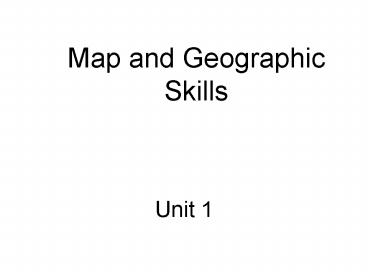Map and Geographic Skills - PowerPoint PPT Presentation
1 / 31
Title:
Map and Geographic Skills
Description:
Types of Thematic maps Population density population distribution economic activity resources languages ethnicity Types of Thematic maps cont. Climate ... – PowerPoint PPT presentation
Number of Views:219
Avg rating:3.0/5.0
Title: Map and Geographic Skills
1
Map and Geographic Skills
- Unit 1
2
Unit 1 VocabularyMap and Graph Skills
- Absolute location
- atlas
- bar graph
- cardinal directions
- cartographer
- circle graphs
- climographs
- compass rose
- density
- distortion
- Equator
- Mercator Projection
- intermediate directions
- latitude
- legend (key)
- line graph
- longitude
- orientation Physical map
- Polar projection
3
Scale
- Shows the ratio between a unit of length on a map
and a unit of distance on the earth
4
Lines of latitude
- Imaginary lines that measure distance north and
south of the equator
5
Lines of Longitude
- Imaginary lines that measure distance east and
west of the Prime Meridian
6
Relative Location
- Describes a place in comparison to other places
around it
7
Orientation
- Direction -- usually shown on a map using a
compass rose or directional indicator
8
Sources of geographic information
- Geographic Information Systems (GIS), field work,
satellite images, photographs, maps, globes, data
bases, primary sources
9
Mental Maps
- Help people carry out daily activities (ex. Route
to school or the store) - give directions to others
- understand world events
10
4 ways mental maps can be developed and refined
- Compare sketched maps to more formal maps such as
those in an atlas or book - Describe the location of places in terms of
reference points (the equator or Prime Meridian
11
4 ways mental maps can be developed and refined
cont.
- Can describe the location of places in terms of
geographic features and land forms (ex. West of
the Mississippi River, or north of the Gulf of
Mexico)
12
4 ways mental maps can be developed and refined
cont.
- Describing the location of places in terms of the
human characteristics of a place ( ex languages,
types of housing dress, recreation, customs or
traditions
13
What are the standard methods of showing
information on a map
- Symbols
- Colors
- Lines
- Boundaries
- Contours
14
Thematic Maps
- Thematic maps show a theme or a particular idea.
There are many different types.
15
Types of Thematic maps
- Population density
- population distribution
- economic activity
- resources
- languages
- ethnicity
16
Types of Thematic maps cont.
- Climate
- precipitation
- vegetation
- physical
- political
17
Ways map can show change
- Changes in Knowledge
- Map of Columbuss time
- Satellite images
- changes in Place Names
- Formosa, Taiwan, Republic of China
- Palestine, Israel, Occupied Territories
18
Ways map can show change cont.
- changes in Boundaries
- Africa in the 1910s and in the 1990s
- Europe before WWII and after WWII and since 1990
19
Ways map can show change cont.
- Changes in perspectives of place names--Arabian
Gulf v. Persian Gulf - Sea of Japan v. East Sea
- Middle East v. North Africa and Southwest Asia
20
Ways map can show change cont.
- Changes in Disputed areas-- Korea
- Western Sahara
- Former Yugoslavia
- Kashmir
21
Map Projections
- Three types of map projections
- Mercator
- Polar
- Robinson
- All three types have distortion
22
Map Projections cont.
- You can distort area, shape, distance and
direction - A Mercator projection is best used for ship
navigation because of the nice straight lines
23
Mercator projection
- Nice Straight lines
24
Map Projections cont.
- A Polar projection is best used in airplane
navigation. It is easy to plot the Great Circle
Routes used to fly long distances - A Robinson projection is best used for data
representation. Most of the maps in textbooks
are Robinson projections
25
Robinson Projection
- Latitude lines are straight. Longitude lines are
curved.
26
Pie Chart
- Used to show parts of a whole or percentages
27
Bar graph
- Used to show items in relation to others
28
Line Graph
- Used to show loss or gain or information over
several time frames
29
Population Pyramid
- Shows the population of a country or region.
Allows you to break into male and female and by
age groups
30
Climograph
- J F M A M J J A S
- Shows precipitation and temperature averages over
a one year period
31
Practical applications of Geography
- Recycling programs
- conversion of land
- airport expansion
- bicycle paths
- water sources
- air quality
- mass transit































